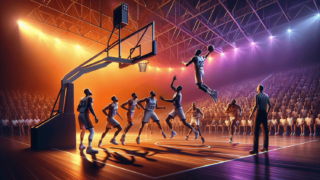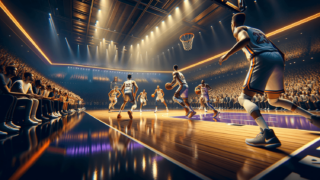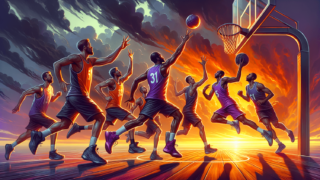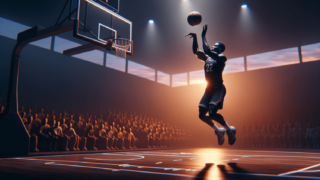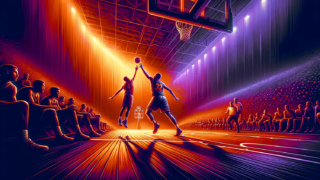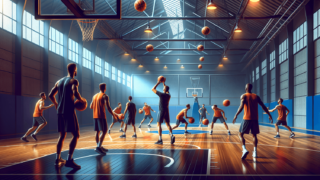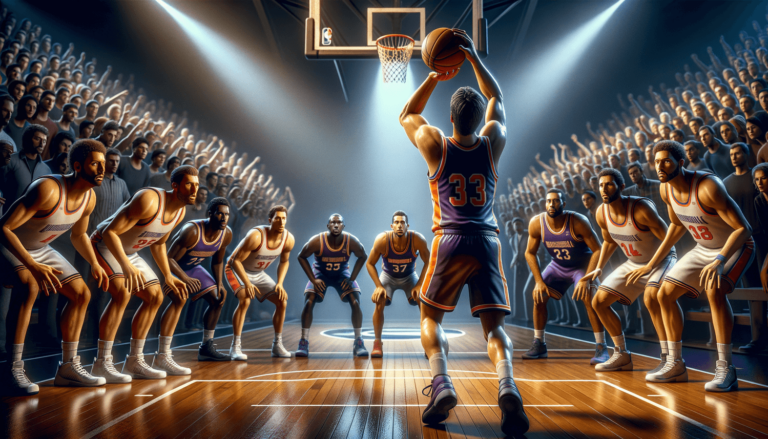
Six-Second Free Throw Rule in Basketball
Written by: Basketball Universe
Last updated:

Welcome to our world of basketball! In today’s blog post, we’ll deep dive into the thrilling topic that is the ‘Six-Second Free Throw Rule in Basketball’. This might sound unfamiliar to some, but fret not, as we’ll dissect the rule from every angle, and leave no stone unturned. Whether you’re a basketball aficionado or a newbie, get ready to have a slam dunk of information coming your way as we explore the clock-ticking excitement of this lesser-known yet vital regulation of the game. Buckle up and let’s jump right in!
Six-Second Free Throw Rule in Basketball
The Six-Second Free Throw Rule in basketball is a regulation that mandates a player to shoot a free throw within six seconds of receiving the ball from the referee. The countdown begins once the player has the ball and ends when the ball leaves their hand for the shot. Failure to adhere to this rule results in a violation, and the free throw attempt is considered null and void.
Understanding the Importance of the Six-Second Free Throw Rule
Basketball can be a fast-paced and thrilling game, where every second counts. Amidst the excitement, certain rules help maintain the game’s flow and uphold the spirit of sportsmanship. The Six-Second Free Throw Rule is one such regulation that adds structure and ensures fair play during free throw situations. To better appreciate this rule, let’s first understand its significance within the game’s framework.
Keeping the Game Moving
The Six-Second Free Throw Rule not only maintains the flow of the game but also ensures that players don’t take an undue amount of time attempting free throws. This rule keeps the game on track and emphasizes the importance of speed and accuracy while shooting a free throw.
Encouraging Sportsmanship and Fairness
Sportsmanship and fairness are vital pillars of basketball. By limiting the time a player has to shoot a free throw, this rule discourages any intentional time-wasting tactics that might be employed to disrupt the opposing team’s momentum. The Six-Second Free Throw Rule ensures equal footing for all teams and keeps the competitive spirit alive.
Getting Acquainted with Basketball’s Free Throw Rules
Before we delve further into the nuances of the Six-Second Free Throw Rule, let’s get a better understanding of the game’s overall free throw regulations. Basketball rules dictate that free throws are awarded when a player is fouled during a shooting attempt, or when the opposing team accumulates a certain number of fouls within a specific period.
Free Throw Attempts and Bonus Situations
Usually, a player is awarded one, two, or three free throws, depending on the situation. When a team exceeds the foul limit in a quarter or half, they enter the “bonus” or “penalty” situation. The fouled team receives additional free throw opportunities, even if the player wasn’t fouled during a shooting attempt.
Free Throw Ettiquite
During free throw attempts, the player must stand behind the free throw line with both feet, keeping them within its 12-foot width. Players positioned along the lane lines must remain outside the key, behind the three-point arc, and the free throw lane area, until the ball is released by the shooter. Once released, players may attempt to get rebounds or block attempts by the opposing team.
Mastering the Art of the Six-Second Free Throw
Now that we have a solid foundation of basketball’s free throw rules, let’s explore the Six-Second Free Throw Rule and employ some helpful strategies to stay within the time limit while making the most of your free throw attempts.
Develop a Consistent Routine
Having a consistent pre-shot routine can help reduce anxiety, increase focus, and ensure formulaic shooting. Some players bounce the ball a few times, take a deep breath, or spin the ball in their hands. Find a routine that works for you and allows you to complete the shot within the six-second time frame.
Build Muscle Memory
Practicing free throw shooting helps build muscle memory and enhances your overall consistency. With enough practice, the body will develop an innate sense of timing and movement, resulting in a smooth, efficient, and time-conscious free throw shooting technique.
Work on Focus and Concentration
Concentration is a critical aspect of successful free throw shooting. Developing techniques to block out distractions and enhance focus can translate into better overall performance within the six-second time limit. Some players use visualization to picture the ball’s trajectory and the sound of the net swishing before attempting a free throw.
Handling Pressure and Tactics during Six-Second Free Throws
The clock is ticking, and the crowd is roaring—navigating the high-pressure environment during a six-second free throw can be challenging. Here are a few tips to help players stay cool, composed, and focused during that crucial six-second countdown.
Embracing the Pressure
Pressure is an integral aspect of competitive sports, and basketball is no exception. Learning to thrive under pressure, rather than succumb to it, can lead to improved performances during crucial free throw situations. Embrace the challenge and transform it into a positive force by being mentally resilient and confident in your ability to excel.
Staying in the Present
Keep your mind fully engaged in the present moment, focusing on the task at hand rather than dwelling on past plays or future consequences. By remaining in the present, you eliminate mental distractions and ensure your full attention is dedicated to executing a perfect free throw within the six-second time frame.
Utilizing Breathing Techniques
Proper breathing techniques can help ease tension, facilitate focus, and alleviate stress during high-pressure situations. Taking slow, deep breaths before attempting a free throw allows the body to relax and get into a rhythm for a successful shot within the allotted time.
Notable Players Who Challenged the Six-Second Free Throw Rule
Basketball history has seen notable players who have pushed the boundaries of the Six-Second Free Throw Rule, showcasing intriguing tactics and unforgettable performances.
Karl Malone ‘The Mailman’ and His Extra Bounce
Karl Malone, a Hall of Famer and the second-highest NBA all-time leading scorer, was infamous for his lengthy free throw routines. Nicknamed ‘The Mailman’ for his consistent scoring, Malone often took extra dribbles or bounced the ball more than necessary before taking the shot, occasionally flouting the six-second rule.
Dwight Howard’s Slow Shot Technique
Dwight Howard, an eight-time NBA All-Star, had a particularly lengthy routine during his free throw attempts. He often approached the six-second limit with his extended motions, sometimes sparking debates among fans and commentators about whether he violated the rule.
Scaling the Countdown to Success
The Six-Second Free Throw Rule in basketball brings a unique mix of excitement, pressure, and discipline to the game. Understanding and mastering this rule can help players enhance their free throw performance, stay composed in high-pressure situations, and contribute to their team’s success on the court. So, stand tall, take aim, and remember—every second counts!
Impact of Six-Second Free Throw Rule on Game Strategy
While the Six-Second Free Throw Rule might seem like a minor detail in the grand scheme of basketball, it can have a significant impact on a team’s overall strategy. Coaches and players must adapt their game plans to factor in this rule and ensure that they capitalize on every free throw opportunity to secure a win.
Advantages of Quick and Accurate Shooting
A player who has developed a knack for executing quick and precise free throws within the six-second limit holds an essential advantage for their team. By consistently converting free throw attempts, the player can keep the scoreboard ticking and decrease the likelihood of free throw violations, delivering an edge in tight games.
Defense Adjustments and Game Tempo
The Six-Second Free Throw Rule encourages teams to develop multi-layered defensive strategies, given the potential impact of free throw violations on the final outcome. In addition, adjusting defensive tactics to minimize the risk of fouls ensures that the game tempo is maintained and reduces the chance of sending opponents to the free-throw line.
Enforcing the Six-Second Free Throw Rule
Enforcing the Six-Second Free Throw Rule falls under the realm of the referee’s duties. Officials play a crucial role in keeping the game fair and within the bounds of basketball rules. Let’s look into how referees effectively enforce this regulation.
Monitoring Free Throw Procedures
One of the referees’ central responsibilities during free throw situations is to ensure that players adhere to procedures and timing stipulations. From handing over the ball to the shooter to observing the countdown, referees continuously monitor the process and enforce the six-second rule.
Dealing with Violations
When a player violates the Six-Second Free Throw Rule, the referee immediately blows the whistle, signaling the violation. The ball is then awarded to the opposing team, and the free throw attempt does not count toward their score. Referees must be vigilant and consistent while applying this rule to ensure fairness and minimize disputes or controversies.
Exceptions to the Six-Second Free Throw Rule
Although the Six-Second Free Throw Rule is generally enforced across various basketball leagues, there are some exceptions in specific situations and at different competition levels.
Amateur and Youth Basketball
In amateur, youth, or recreational leagues, the six-second rule may sometimes be leniently enforced to prioritize enjoyment and learning rather than strictly following the time limit. However, this approach varies depending on the league and the referees’ discretion.
Intentional Delaying Tactics
When a player intentionally delays the game by violating the six-second rule, referees have the authority to issue a technical foul, penalize the offending player, and grant the opposing team possession of the ball. This discouragement of unsporting conduct is essential to upholding the spirit of basketball and maintaining a dynamic gameplay environment.
Evolution of the Six-Second Free Throw Rule
Over the years, the Six-Second Free Throw Rule has evolved, as different leagues and organizations have adopted diverse approaches to its enforcement. However, the core purpose remains the same: to keep games moving smoothly and ensure a fair and competitive atmosphere for everyone involved in the sport.
Frequently Asked Questions about the Six-Second Free Throw Rule
In this section, we answer ten frequently asked questions that encompass various aspects of the Six-Second Free Throw Rule and its impact on the game. Whether you’re a seasoned basketball enthusiast or a curious newcomer, this FAQ will provide valuable insights into this important rule.
1. Why was the Six-Second Free Throw Rule introduced?
The Six-Second Free Throw Rule was introduced to ensure the game’s smooth flow and prevent players from taking an excessive amount of time when attempting free throws. The rule enforces a sense of urgency and discourages any intentional time-wasting tactics.
2. Does the Six-Second Free Throw Rule apply to all basketball leagues?
While the Six-Second Free Throw Rule is applicable in most basketball leagues, including the NBA and FIBA, its enforcement may vary in amateur, youth, or recreational leagues. The time limit might be more flexible in such leagues, depending on the organizer’s guidelines and level of competition.
3. When does the six-second countdown start?
The six-second countdown for a free throw attempt starts when the player receives the ball from the referee. The clock stops the moment the ball leaves the shooter’s hand for the shot.
4. What happens if a player violates the Six-Second Free Throw Rule?
If a player violates the Six-Second Free Throw Rule, the free throw attempt is nullified, and the ball is awarded to the opposing team. Additionally, a technical foul might be issued if the referee deems the violation as an intentional delaying tactic.
5. Can a player be penalized for releasing the ball after the six-second limit?
Yes, it is considered a violation if a player releases the ball after the six-second limit. The free throw attempt will be nullified, and the ball will be awarded to the opposing team.
6. Can the Six-Second Free Throw Rule be challenging for players to follow?
While the Six-Second Free Throw Rule can be challenging for some players, especially in high-pressure situations, regular practice, focus, and a consistent pre-shot routine can help players adhere to the rule easily.
7. How can a player improve their free throw performance within the six-second limit?
A player can improve their free throw performance within the six-second limit by developing a consistent pre-shot routine, practicing free throw shooting to build muscle memory, and working on focus and concentration techniques.
8. Are there any famous players who have violated the Six-Second Free Throw Rule?
Some notable players, like Karl Malone and Dwight Howard, have occasionally pushed the boundaries of the Six-Second Free Throw Rule. However, strict enforcement of the rule was not always applied in such cases, sparking debates and discussions among fans and commentators.
9. Can a timeout be called during a free throw attempt?
A timeout cannot be called during an ongoing free throw attempt. However, a coach or player can call a timeout before or after a free throw, depending on the league and its regulations.
10. Does the Six-Second Free Throw Rule apply to technical free throws?
Yes, the Six-Second Free Throw Rule also applies to technical free throws. The shooter must release the ball within six seconds of receiving it from the referee, regardless of the type of free throw being attempted.
Featured Posts
- No pillar pages found.
